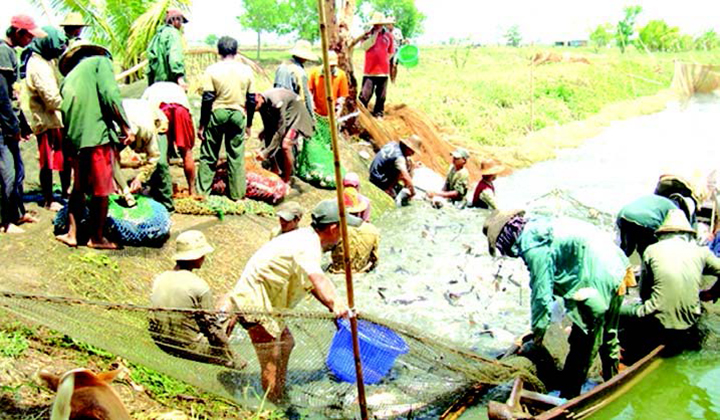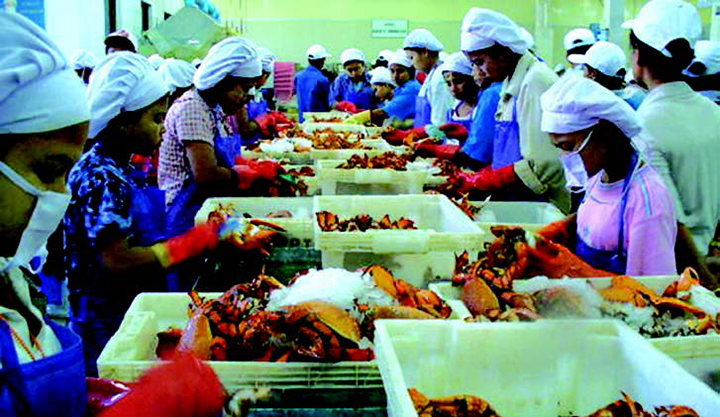October 02, 2019
By Win Kyaing (Fisheries Department)
According to the 2018 statistics of Myanmar Fisheries Department, there are total 491345 acres of fish farms— 247007 acres of fish
farms and 244338 acres of prawn farms. Kinds of fish include freshwater fish—carp, white carp, large carp, river catfish, freshwater pomfret, golden Hamilton carp, grass-eating carp, big-head carp, climbing perch, giant sea perch, banded snakehead, and freshwater catfish.
Myanmar Fish Breeding
Myanmar people have very much consumed varieties of local fish species for a long time; in the last two decades, fishes in natural lakes have become rare, thus rising their prices and farm fishes becoming main foods especially a variety of carps. This kind of carp tops among the 10 items of fishes exported; Myanmar is the second-largest carp exporting country in the world. River catfishes are mostly second-largest bred in the country for local consumptions and dry raw materials of fish products. Other fish species are locally consumed and only some have been exported. Exports from fish farms have generated incomes of over US$ 100 million.
Prawn Breeding
There are as many as 244338 acres in prawn breeding sector; three kinds of species of lobsters, spotted prawns and vannamei are bred and produced on a large scale. Freshwater lobsters are being bred separately as well as mixing with different kinds of fishes. Saltwater spotted prawns are being cultured in traditional ways in ponds along the coastal regions especially in the Rakhine State which produced en masse. The number of young spotted prawns in nature have decreased; at the same time, output of the spotted prawns from a fish-breeding pond has become lower and lower. While prawns have been bred and produced in ponds by means of scientific methods in Ngwe Saung Area, Ayeyawady Region,Kyunsu Township, Taninthaye Region, Thayechaung and Kawthoung Townships and Thandwe township, Rakhine State.
Scientific breeding systems
Traditional methods of fish and prawn breeding are practiced in Myanmar, and modern, scientific breeding techniques are really needed. To produce young fish and prawns with the help of multi-purpose incubators, high breeding techniques, modern food businesses, high-price productions, programs for exporting international markets, research and developments must be managed for their changes.
The productions of fish and prawns filled with opportunities and potentials should be prioritized to upgrade food sectors for playing an important role in the sectors. As food raw materials getting from agricultural byproducts are used, meeting the requirements of food materials. These raw materials should be privately owned in close contact with agricultural planning. Food processing factories must be encouraged by all means.
Marine products were exported according to the following chart. During a period of 11 months from 1 October, 2018 to 31 August, 2019, 544533.187 metric tons were exported generating an income of US$ 667.007 million. But little progress has been made during a period of 14 years, so the momentum of progress cannot be seen considerably.
Myanmar’s climatic similarity with other ASEAN neighbors as Vietnam and Thailand, the food is enough for consumption for its citizens and tourists. In 2018, Vietnam exported marine products worth of US$ 8800 million and Thailand did over US$ 6000. Vietnam possesses 48.81% of land areas of those of Myanmar; but agriculture and animal husbandry (especially fisheries) and systematic policies, planning and projects were applied to bring success in a very short time.
Opportunities
Political changes have been made in Myanmar under the incumbent government to exempt from political and economic blockage; trading rights as the generalized system of preferences(GSP) must be firmly grasped. The utilization of state-owned natural resources, such as water and land, and workforce as well as the exploitation of opportunities offered by the moderate climate need to be balanced in accordance with the demand in the international market. Choosing kinds of fish and prawns in accordance with our climate must be managed in modern, multipurpose planning.
Fishery sector plays an important role for the security and safety of our national food programs for healthy and highly intelligent citizens, programs for rural developments, creations of job opportunities and programs for raising foreign exchanges are interrelated; Fishery businesses are big indeed. For the multi-purpose developments of our country, the fishery sector is also important for the fulfillment of comprehensive policies, national-level planning and projects must be implemented in order not to miss successes in the future.
(Translated by Arakan Sein)




